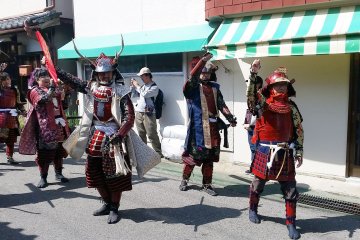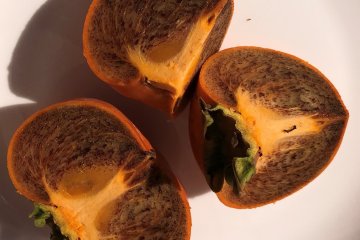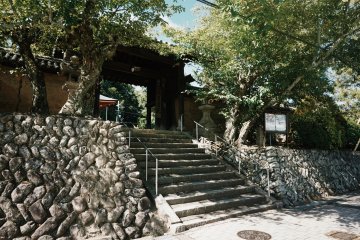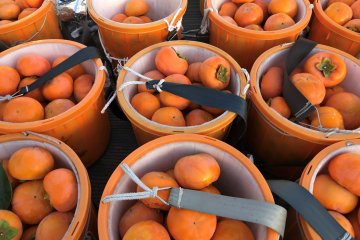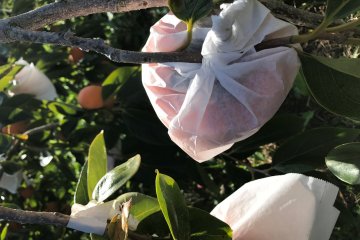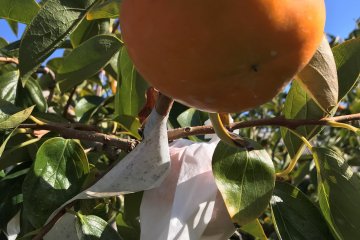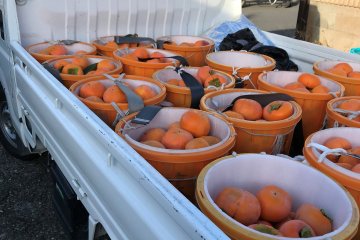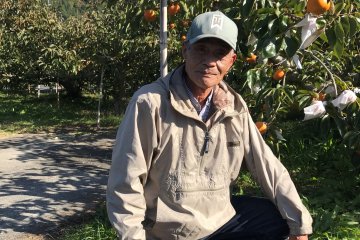Yume means dream in Japanese. This “dream” has become the brand name of a very expensive type of persimmon that is produced in the Kudoyama area of Wakayama Prefecture.
We met Mr. Yuichi Nakatani, Chairman of the Yume Association to learn more about this special fruit and about the persimmon farmers in this area.
Once popular…
First, let’s wind back. Refined sugar in the old days was an expensive commodity. This is why people tried to find alternatives for their sweets intake and Amagaki, or sweet persimmon, was the best option. People had no refrigerator and needed ways to preserve food. Shibugaki, the astringent persimmon, was a good candidate for that. This made kaki, together with mochi (glutenous rice cake) an ideal food.
What’s more, persimmon have medicinal properties. Eating persimmon can contribute to lowering blood pressure. An old Japanese saying goes: “When the persimmon turns orange-red, the doctor turns pale blue.”
In other words, when persimmon are ripe for harvest and eating, less people will visit the doctor’s office. Eating kaki was part of people’s diet and thanks to the health-promoting properties of kaki people stayed healthy.
Traditionally kaki fruits contained many seeds. This was once considered a sign of fertility as many seeds were equated to many children. Many children were thought of as a blessing.
…then almost forgotten
When refined sugar became less expensive and all households could afford a refrigerator, persimmon became a less interesting food option. Not an ideal situation for farmers who cultivate persimmon in their orchards. Ideas were needed to do something about the decreasing interest and hence less income for the owners of kaki orchards
During the Second World War there was no space for orchards as all available land was used to grow rice. However, in the 1950s Kudoyama farmers began to plant persimmon trees again.
One of them was Mr. Yuichi Nakatani’s father. Mr. Yuichi Nakatani is now in his 80s and he is still trying to keep up the business. He is the leader of a group of kaki farmers in this area who wanted to aim higher than just growing and selling persimmon. They wanted to follow their dream…


Creating a dream
At the end of the 1990s their dream was to actually grow their business. There were 20 of them who until then had battled for themselves. They sold tasty sweet kaki, produced with extra care, in small batches to a higher price.
They all agreed that they wanted to set a standard for the type of high-end product that they produced and wanted to introduce a method to keep this standard. So, they introduced a sensor that can measure the sweetness of a persimmon and judge the ripeness by its color. Using this sensor would ensure a consistently high standard of their kaki fruits.
In order to brand their product, they thought of a name and they settled for Yume. After all, it was their dream to grow a big brand, make a lot of money and become famous.

Limited supply
There is a lot of effort that goes into making a kaki queen. First of all, there is soil preparation and fertilization. Then the persimmon trees are pruned. Next comes the “picking of buds” as a way of fruit management. Out of 20 flowers on a branch of the tree, only 1 or 2 flowers will be left, all others will be removed. In the end, there will be only 1 fruit on each branch of the persimmon tree. So far this is common procedure for all persimmon.
But here is the extra bit of service: from mid-August the remaining fruits are being covered by ventilated paper bags that protect them against heat, rain and insects. These paper bags allow the fruits to ripen gently.
There are only 6,000 kaki fruit candidates each year that make it into the Yume category. They are carefully selected after being tested with this special censor.
Dream versus Hope
They also thought about how they could ensure a continuation of sales. The Japanese concept of “tsunagaru”, to be connected, came in handy. They wanted to connect their dream with their customers. They wanted to sell their dream, not just a persimmon.
This queen of a persimmon is sold under the name of Yume in the Kansai area, where this group of Kudoyama kaki farmers has the monopoly through contracts with sales outlets.
In the Kanto area a sub-line of the Yume brand, which is less sweet, is sold under the name of Nozomi. Rather than selling a dream, in the Tokyo area they sell hope.
The kanji for kaki in Japanese, 柿, is made up of the components木, 亠, and 巾 written in 9 strokes. The first kanji for hope or kibo (希望) is made up of 7 strokes and very similar components. This is also the first kanji for Nozomi (希実). Considering all this, the brand name for the Kanto area was born.
Only 18-20% of the selected Yume fruits are Yume Nozomi, which are close to being organic.
Pricy present
The farmers ensure that there a limited supply of these rare fruits so that they can be sold to a premium price. Some years ago, 5 or 6 Yume fruits would fetch yen 30,000. In recent years, this price has come down to yen 10,000, which is still substantial for a few fruits!
Lowering the price was a conscious decision made by the farmers. They wanted to make their priced fruits more affordable to get repeat customers.
The seller network is fixed. These sellers make their reservations directly with the farmers and then they sell Yume gift sets to specific outlets. This means that you cannot actually buy Yume kaki at a department store like you could buy many other expensive food products.
Yume are not just bought for daily consumption. They are packaged and presented in a gift box. This is the gift that you would give to someone special, provided you manage to get a box!

Caring for the planet
Mr. Nakatani did some backpacking in Europe for one month when he was younger. He said he wanted to visit London, Paris and Zurich to broaden his horizon. He is well-aware of environmental problems and he does not hold back with his opinion.
He says that governments should protect and support farmers, fishers and foresters so that they can produce food and essential products for people. Protecting farmers in particular means protecting the planet.
Farmers cannot be cheated; they know that global warming is real, he says. They watch carefully what they grow and they can see changes in recent years.
He has noticed many black spots on his persimmon in recent years. These black spots are burn marks. The climate is becoming too hot for persimmon now so that the fruits literally burn under the sun.
He is very worried for the future of persimmon farmers in the Kudoyama area. He thinks that persimmon orchards will gradually be moved to cooler places in Japan such as the Shonai region in Yamagata Prefecture or Niigata and Gifu Prefectures.
These places, together with Ehime, Fukuoka, Shimane and Hiroshima Prefectures, are already amongst the persimmon producing areas in Japan but currently the main production centers are in Wakayama and Nara Prefectures.
The challenge ahead
And there is another problem, namely a lack of young farmers. The Yume Association has currently 32 members but only two of them are "young". One member is in his 30s and another member in his 40s, most are in their 70s though.
The challenge that the older farmers are facing is to teach the young farmers well so that they stay in business, explains Mr. Nakatani. This means they keep growing and selling Yume until they are in their 70s.
Since there is only 1 harvest per year, this amounts to only 40 harvest for the youngest member of the association. To keep going, year after year, is a challenge and possibly the real dream and hope for these persimmon farmers.



